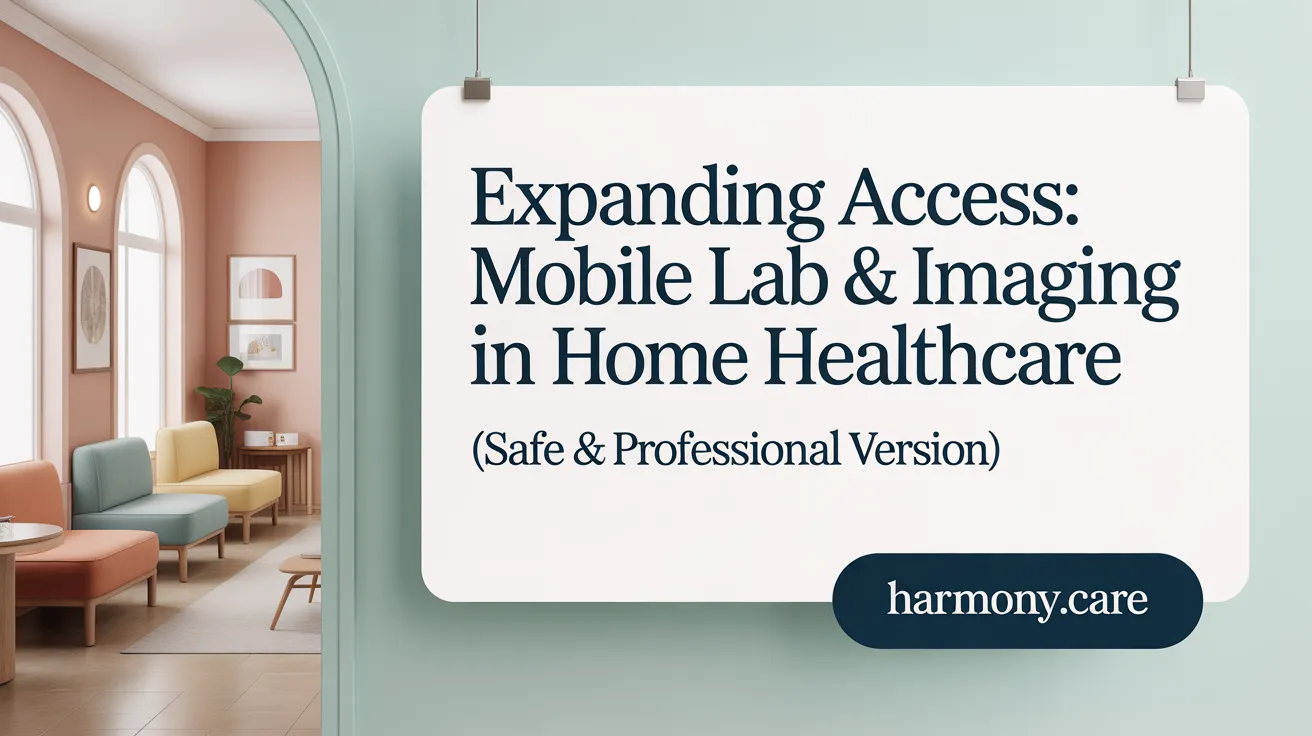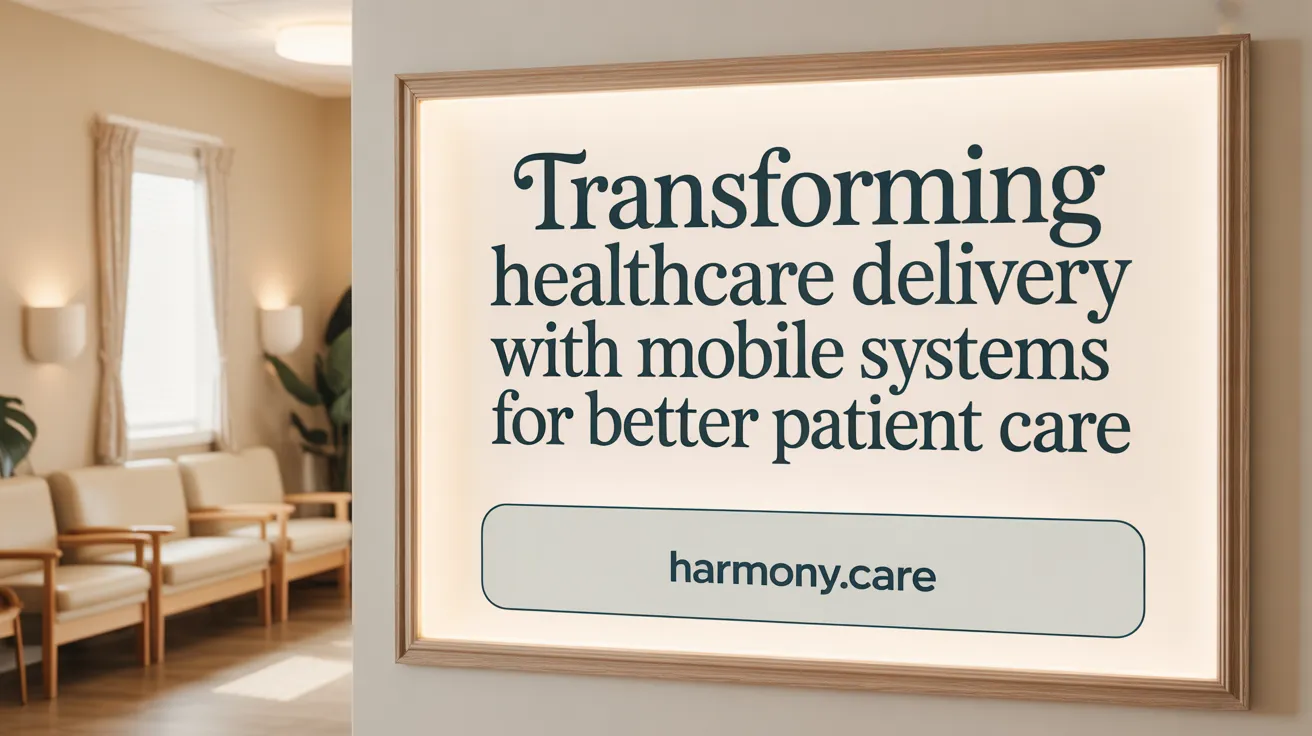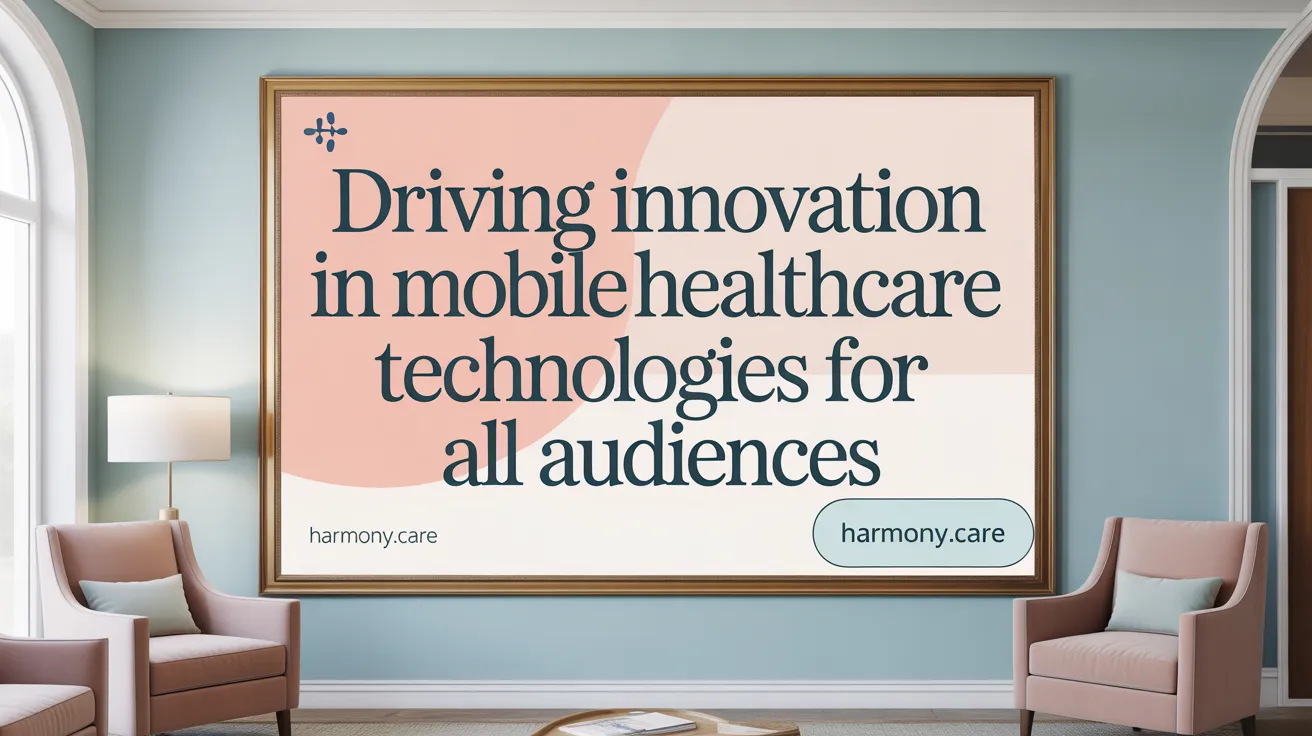Transforming Healthcare Delivery Beyond Clinical Walls
Mobile laboratory and imaging technologies are revolutionizing home healthcare by delivering critical diagnostic services directly to patients’ homes. These innovations enhance patient comfort, streamline care delivery, and expand access to essential health services, especially for vulnerable populations. This article explores the integral role mobile labs and imaging systems play in home healthcare, their applications, and their impacts on patient outcomes and healthcare workflows.
Key Roles and Benefits of Mobile Labs and Imaging in Home Healthcare

What are the roles and benefits of mobile labs and imaging technologies in home healthcare?
Mobile labs and imaging technologies are transforming home healthcare by bringing essential diagnostic services directly to patients' doorsteps. These on-site mobile solutions facilitate a wide range of tests, including blood work, urinalysis, diagnostic imaging like X-rays, ultrasounds, and even advanced imaging such as portable CT scans. This approach significantly reduces the need for patients to visit hospitals or clinics, cutting down transportation time and costs.
One of the primary advantages is enhancing patient comfort and safety. Patients, especially the elderly, chronically ill, or those with mobility challenges, receive timely diagnostics in familiar environments. This minimizes stress and physical risks associated with transportation. During health crises like COVID-19, mobile labs help inhibit infection spread by limiting patient movement and exposure.
Early diagnosis and continuous health monitoring are crucial benefits. Mobile imaging and testing enable rapid detection of urgent conditions like strokes, heart issues, or infectious diseases. For example, mobile CT units can quickly diagnose strokes, ensuring swift treatment that can save lives. Portable ultrasound and EKG devices also support ongoing health management in community settings.
These services play a vital role in addressing healthcare disparities by extending diagnostic access to underserved communities, rural areas, and vulnerable populations such as nursing home residents or individuals with disabilities. Mobile solutions increase health equity by overcoming geographical barriers.
Furthermore, mobile labs and imaging systems improve overall healthcare system efficiency. They alleviate hospital and outpatient center loads, reduce waiting times, and support more personalized, proactive care. With rapid results and expert interpretation, clinicians can make quicker decisions, resulting in better patient outcomes and optimized resource use.
| Aspect | Benefits | Additional Details |
|---|---|---|
| Convenience | On-site testing and imaging | Immediate results, reduced hospital visits |
| Patient Safety | Less stress and risk | Avoiding transport, exposure to infection |
| Early Diagnosis | Swift detection | Critical in emergencies like strokes |
| Health Equity | Expanding access | Reaching remote and underserved areas |
| System Efficiency | Streamlined care | Reduces hospital burden and improves outcomes |
Overall, mobile labs and imaging are essential to advancing patient-centered, accessible, and efficient healthcare, especially within the home and community settings.
Applications and Utilization of Mobile Lab and Imaging Services at Home
 Mobile diagnostic services have revolutionized the way healthcare is delivered to patients in their homes and community settings. These services primarily rely on portable equipment such as mobile X-ray machines, ultrasound devices, EKG monitors, and blood analyzers. This technology allows healthcare providers to conduct essential testing and imaging procedures right at the patient's residence, eliminating the need for disruptive hospital visits.
Mobile diagnostic services have revolutionized the way healthcare is delivered to patients in their homes and community settings. These services primarily rely on portable equipment such as mobile X-ray machines, ultrasound devices, EKG monitors, and blood analyzers. This technology allows healthcare providers to conduct essential testing and imaging procedures right at the patient's residence, eliminating the need for disruptive hospital visits.
In-home healthcare settings, mobile labs and imaging units facilitate a wide range of diagnostic actions. For example, they can perform blood tests, urinalysis, diagnostic imaging like X-rays and ultrasounds, and various health screenings. These on-site procedures ensure timely diagnosis, especially for vulnerable populations such as those with chronic illnesses, elderly adults, or individuals with disabilities.
Advanced telemedicine systems are integrated into mobile diagnostics to enhance service delivery. Images and test results can be transmitted instantly to remote radiologists or specialists for interpretation. Platforms such as Radiology Information Systems (RIS) provide 24/7 access to images and reports, with rapid turnaround times—sometimes as quick as 30 minutes for urgent cases. This combination of portability and connectivity supports prompt clinical decisions, streamlining treatment pathways.
Mobile labs and imaging services are particularly used in healthcare environments such as hospice care, nursing homes, assisted living facilities, and rural communities. In these settings, they assist in monitoring health status, adjusting treatments, and avoiding unnecessary hospitalizations. Emergency situations and disease screening programs also benefit from mobile units, especially in outbreak control or remote area diagnostics.
Collaboration with third-party providers and hospitals enhances the reach and efficiency of these mobile services. Hospitals often partner with mobile labs to extend their diagnostic capabilities directly into the community or patient homes. Such partnerships expand access, reduce patient travel burdens, and improve overall healthcare outcomes.
Overall, the application of mobile lab and imaging services in home healthcare ensures that diagnostic testing is more accessible, faster, and convenient. These services play a pivotal role in proactive health management, disease screening, and delivering patient-centered care in diverse environments.
Supporting Patient Care Through Portable Diagnostics

How do mobile diagnostics, such as portable X-rays, support patient care and diagnostics at home?
Mobile diagnostics, including portable X-ray systems, are transforming healthcare by bringing essential imaging services directly to patients' bedsides or homes. These devices allow healthcare providers to perform immediate imaging—such as X-rays—without the need to transport patients to hospitals or imaging centers. This capability is crucial in delivering timely care, especially for patients who are frail, elderly, or have mobility challenges.
The convenience of bedside imaging speeds up diagnosis and treatment, enabling quicker clinical decisions. For example, in emergency settings or at home, mobile X-ray units can swiftly detect injuries, infections, or internal issues, reducing delays that often occur with traditional offsite imaging. This rapid turnaround can be life-saving, particularly in acute situations like strokes or trauma cases where every minute counts.
Mobile diagnostics greatly benefit vulnerable groups, such as residents of nursing homes, pediatric patients, or those with chronic illnesses. They decrease the stress associated with hospital visits and transportation, providing comfort and dignity by keeping patients in familiar environments.
Furthermore, these systems broaden access to essential diagnostics in underserved and remote areas. Regional hospitals, clinics, and community health programs now rely on portable imaging to fill gaps in healthcare delivery, effectively addressing disparities in access.
In urgent and home care settings, mobile diagnostic tools streamline workflows. Care providers can perform on-site tests, make immediate assessment, and initiate treatment plans without logistical delays. This efficiency reduces hospital admissions, minimizes unnecessary transfers, and optimizes resource utilization.
In summary, portable X-ray technology advances patient care by offering immediate, accessible, and safe imaging options. The impact extends across diverse healthcare environments, fostering timely interventions, enhancing safety, and improving overall health outcomes.
Enhancing Healthcare Delivery, Workflow, and Safety with Mobile Systems
 Mobile lab and imaging systems are transforming healthcare environments by delivering diagnostic services directly where patients need them most—often within homes or community settings.
Mobile lab and imaging systems are transforming healthcare environments by delivering diagnostic services directly where patients need them most—often within homes or community settings.
One of the most significant impacts is promoting rapid, on-site diagnostics. Mobile labs can perform blood tests, urinalysis, and health screenings immediately at the point of care. Similarly, mobile imaging units, equipped with advanced technology such as portable X-rays, ultrasounds, and CT scans, facilitate quick visual assessments necessary for timely clinical decisions.
This immediacy accelerates treatment planning, particularly in urgent cases like strokes or trauma, where every minute counts. For healthcare providers, having immediate access to diagnostic results minimizes delays, streamlining workflow and improving communication. Clinicians, radiologists, and other specialists can review images and lab results within hours or even minutes thanks to integrated electronic systems, which enhances collaboration and reduces administrative burdens.
Furthermore, mobile diagnostics play a crucial role in reducing infection risks. By limiting patient transfers and enabling bedside testing, these systems reduce exposure to potentially contaminated environments—vital during pandemics or infectious disease outbreaks.
This not only protects patients but also safeguards healthcare staff from unnecessary contact with infectious agents. Additionally, mobile imaging minimizes the physical and emotional stress associated with transportation, especially for vulnerable populations such as the elderly or mobility-challenged residents of nursing homes.
Mobile systems significantly extend health equity. They reach remote, rural, or underserved communities where traditional healthcare infrastructure might be lacking. By providing access to advanced diagnostic tools such as portable MRI or mammography units, they help bridge disparities, ensuring more equitable healthcare delivery.
Operationally, these systems enhance safety and efficiency in home healthcare and community settings. Patients benefit from high-quality, timely diagnoses without leaving familiar environments, preserving comfort and dignity. Healthcare providers can make immediate intervention decisions, reducing hospitalization times and improving overall outcomes.
In summary, mobile lab and imaging systems influence healthcare positively by expediting diagnostics, streamlining workflows, reducing infection risks, expanding access to underserved populations, and improving patient safety and comfort in diverse settings.
Types of Mobile Imaging and Laboratory Technologies Used in Home Healthcare
What types of mobile imaging and laboratory systems are used in home healthcare?
In home healthcare, a variety of mobile systems allow clinicians to perform essential diagnostic tests right where the patient is. Portable X-ray machines are commonly used for quick imaging of bones, lungs, and internal organs, providing immediate visual data without moving frail or immobile patients.
Mobile ultrasound devices are versatile tools for assessing soft tissues, fetal health, and internal organs. These devices are lightweight and can be operated easily at the patient's bedside, delivering real-time images that support timely medical decisions.
Wireless ECG monitors are employed for continuous or spot heart rhythm analysis. These compact devices transmit data wirelessly to healthcare providers, facilitating remote monitoring of cardiac health.
For more advanced diagnostics, mini MRI systems and portable CT scanners are increasingly available. These sophisticated units can produce detailed brain and body scans and are designed to be used in non-traditional settings like patient homes or community health centers.
All these tools are engineered to be compact, lightweight, and battery-powered, ensuring they can be deployed efficiently in diverse environments. Wireless data transmission capabilities enable seamless upload of images and reports to specialists located remotely, supporting expert consultation without delay.
This integration of technology not only broadens healthcare access, especially in underserved or remote areas, but also reduces the need for patient transportation. It leads to quicker diagnoses, more personalized care, and better health outcomes for individuals with mobility challenges or chronic illnesses.
| Technology Type | Typical Use | Features | Benefits |
|---|---|---|---|
| Portable X-ray | Bone, lung imaging | Wireless, battery-powered | Fast, on-site imaging; reduces patient transfer |
| Ultrasound | Soft tissue, organ assessment | Handheld, real-time imaging | Immediate results; useful in acute and chronic conditions |
| EKG Devices | Heart rhythm analysis | Wireless, wearable | Continuous monitoring; supports remote diagnosis |
| Mini MRI | Brain, body imaging | Compact, high-resolution | Detailed imaging in constrained settings |
| Portable CT | Detecting stroke, injuries | Small form factor, AI-enabled | Rapid, high-quality scans at bedside |
The evolution of mobile imaging technology significantly enhances healthcare delivery by making advanced diagnostics more accessible, especially for those with limited mobility.
Innovations and Future Directions in Mobile Healthcare Technologies

How are technological advancements transforming mobile healthcare?
Recent innovations have made mobile labs and imaging units more adaptable and efficient. Equipment is becoming lighter and more durable, allowing for ease of transport to remote or hard-to-reach areas. Solar-powered units are emerging as a solution to the challenge of reliable power sources in off-grid locations, enhancing operational independence and sustainability.
How is mobile healthcare integrating with telemedicine and AI?
Mobile imaging and testing services are increasingly connected with telemedicine platforms. This integration permits real-time consultation with specialists and rapid sharing of diagnostic results. AI enhances this process by supporting image analysis, improving accuracy, and enabling faster decision-making, especially in critical conditions like strokes or infections.
What role do mobile health apps play in remote monitoring?
Mobile health applications extend healthcare beyond clinics and labs. They enable patients and healthcare providers to monitor vital signs, manage medications, and report symptoms remotely. During health crises like pandemics, these tools help in tracking symptoms and adherence to treatment, reinforcing proactive care.
What policies are supporting the growth of mobile healthcare?
Public-private partnerships, along with government initiatives, are crucial in funding and streamlining mobile health deployment. Regulatory efforts focus on ensuring data security, standardizing device quality, and facilitating integration within existing health systems, making mobile services more accessible and reliable.
What are ongoing research areas related to mobile health benefits?
Researchers are evaluating long-term health outcomes resulting from mobile services, with a focus on cost-effectiveness and treatment efficacy. Studies also explore how AI can further improve diagnostic accuracy, streamline workflow, and personalize patient care, paving the way for smarter, more responsive healthcare models.
| Technology Focus | Development Area | Impact on Mobile Healthcare | Additional Notes |
|---|---|---|---|
| Equipment | Lighter, durable, solar-powered | Easier deployment in remote areas | Sustainability focus |
| Integration | AI, Telemedicine | Faster, more accurate diagnostics | Enhances remote expert support |
| Apps & Software | Remote monitoring platforms | Continuous patient care | Supports chronic disease management |
| Policy | Funding, regulation | Broader access, improved security | Encourages innovation |
| Research | Long-term outcome studies | Evidence-based improvements | Guides policy and technology adoption |
Embracing Mobile Lab and Imaging Technologies for Enhanced Home Healthcare
Mobile laboratory and imaging technologies are pivotal in transforming home healthcare by bringing advanced diagnostics directly to patients’ doorsteps. They improve patient comfort, safety, and health equity while driving efficiencies in care delivery and diagnostics. Continued innovation, integration with telemedicine, and supportive policies will further expand their impact, making proactive and patient-centered home healthcare a practical standard. Embracing these technologies promises not only improved health outcomes for vulnerable populations but also a more responsive and accessible healthcare system for all.
References
- Role of Mobile Labs in Expanding Access to Healthcare ...
- The Benefits of Mobile Imaging for Home Health and Hospice
- Bringing imaging to the people: Enhancing access and ...
- A tool for healthcare and a boon in pandemic - PMC
- How Mobile X-Ray Services Simplify Care in Nursing Homes
- What Is Mobile Imaging?
- Rise of mobile medical imaging to revolutionise healthcare
